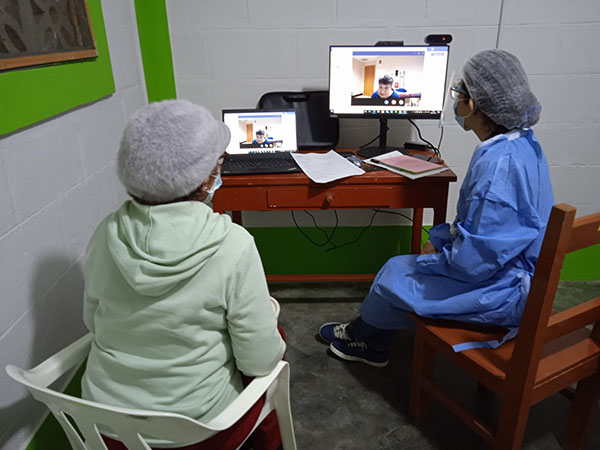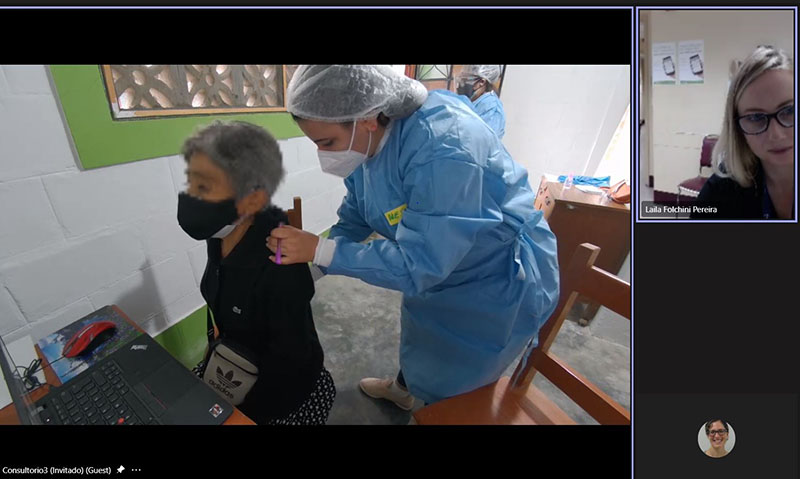Trinity Health Mid-Atlantic combines technology and volunteerism to treat patients a world away
February 20, 2022Categories: Blog Posts, COVID-19
 Over 3,000 miles of mostly open sea separates Wilmington, Del., and Chulucanas, Peru. But for a team of medical volunteers from Trinity Health Mid-Atlantic (THMA) working with Global Health Ministry (GHM), Trinity Health’s international ministry, that distance is instantly traversed with the click of a mouse to hold telehealth visits with underserved patients in need of medical care.
Over 3,000 miles of mostly open sea separates Wilmington, Del., and Chulucanas, Peru. But for a team of medical volunteers from Trinity Health Mid-Atlantic (THMA) working with Global Health Ministry (GHM), Trinity Health’s international ministry, that distance is instantly traversed with the click of a mouse to hold telehealth visits with underserved patients in need of medical care.
Historically, GHM has hosted two medical-surgical mission trips to Chulucanas every June and October since 1989, thanks to the support of colleagues from across Trinity Health who volunteer to serve in clinical and support roles. (GHM also conducts primary care missions to Guatemala, Jamaica, and Haiti—visit www.globalhealthvolunteers.net for more information.)
During the mission trips to rural northern Peru, the medical teams conduct primary care clinics for over 2,000 patients and hold community health education sessions. The surgery teams perform an average of 200 adult and pediatric surgeries each year for patients who could not otherwise feasibly afford to seek the treatment themselves.
Adapting to the pandemic
GHM’s volunteer international telemedicine program launched in June 2021, after the COVID-19 pandemic caused the cancellation of GHM’s mission trips in 2020. The program was a group effort between Saint Francis Hospital in Wilmington and the Technology and Information Systems (TIS) Department at Trinity Health’s Michigan headquarters, partnering with GHM.
Robert Monteleone, MD, a family medicine physician at Saint Francis Family Medicine as well as the residency director at Saint Francis Hospital and the medical director for the Delaware Care Collaboration, was scheduled for the GHM mission trip to Peru in June 2020. When that trip was cancelled, GHM staff members saw an opportunity to pilot a telemedicine program in its place. Coincidently, so did Dr. Monteleone.
During a previous mission trip to Peru, Dr. Monteleone had taken notice of the higher-than-expected quality of the internet service there in Chulucanas, thanks to music.
“I was listening to satellite radio [while in Peru] when I realized how strong the internet connection was,” Dr. Monteleone recalled. “I thought, has telemedicine ever been considered?”
“Once we proposed the idea to GHM’s Board of Directors, who fully supported the concept, we moved forward full throttle,” said Sister Mary Jo.
Dr. Monteleone wondered if there was a way to help patients over time who had chronic health problems. It was a light-bulb moment that would lead to the formation of an innovative global health initiative.
After the 2020 missions to Chulucanas were cancelled, Sister Mary Jo McGinley, executive director for GHM, asked Dr. Monteleone if Saint Francis would be interested in serving as a pilot site for a telemedicine program.
“Once we proposed the idea to GHM’s Board of Directors, who fully supported the concept, we moved forward full throttle,” said Sister Mary Jo.
Sister Mary Ann Dillon, a GHM Board member and Trinity Health’s executive vice president for Mission, then asked Marcus Shipley from Trinity Health’s TIS Department to lend support to the project, and plans for a new telehealth program were underway.
Building a virtual family medicine practice
 In partnership with the Diocese of Chulucanas, which oversees local operations for the Peru-based side of the GHM medical mission program, the team from Trinity Health helped convert three rooms within a health center in Chulucanas—the building normally used for the twice-annual mission trips—into telehealth exam rooms.
In partnership with the Diocese of Chulucanas, which oversees local operations for the Peru-based side of the GHM medical mission program, the team from Trinity Health helped convert three rooms within a health center in Chulucanas—the building normally used for the twice-annual mission trips—into telehealth exam rooms.
Mark Phelps and Frank Salvati from the Trinity Health TIS Department were pivotal to complete the transformation. Phelps, senior manager and enterprise architect, coordinated the technical design of the virtual rooms and solicited Microsoft and Lenovo Peru to donate all the computers and web cameras needed to get the program live. Salvati, enterprise architect, created a secure electronic medical record system using SharePoint, allowing the GHM telehealth team to perform a variety of essential duties, such as store documents, run reports, track vital signs like blood pressure, record diagnoses, and prescribe follow-up care.
Saint Francis Family Medicine practice faculty and residents, working in collaboration with local nurse coordinators in Chulucanas, conduct the patient encounters for each telehealth session. The Chulucanas staff facilitate functions such as scheduling patient appointments, conducting patient triage and coordinating all follow-up care prescribed by the Saint Francis physicians.
Patients in Chulucanas can virtually visit with the Saint Francis physicians via Microsoft Teams every other Thursday from 8 to 9:30 a.m. Common types of visits are with patients seeking treatment for both acute and chronic conditions, with complaints varying from skin conditions to abdominal pain to chronic conditions, such as diabetes, hypertension and heart failure management.
Three members of the Saint Francis faculty team speak Spanish and have traveled with GHM on prior missions, giving them an appreciation and understanding of the culture and environment of the patients they serve. Sister Mary Jo identifies that experience as key to the success of the program and the reason GHM picked Saint Francis for the pilot. Many of the Saint Francis residents are bilingual in English and Spanish as well, and the team has reliable access to volunteer interpreters when needed.
Patients in Chulucanas can virtually visit with the Saint Francis physicians via Microsoft Teams every other Thursday from 8 to 9:30 a.m. Common types of visits are with patients seeking treatment for both acute and chronic conditions, with complaints varying from skin conditions to abdominal pain to chronic conditions, such as diabetes, hypertension and heart failure management.
Donations to GHM help provide the funding needed for the follow-up care prescribed for patients after their virtual visit. GHM purchases and ships the medication available onsite in Chulucanas and provides funding to cover prescribed medications that need to be purchased locally in Peru. Funding is also available for patients who need additional testing or treatments as well as for those referred for more complex care.
On average, about 12 patients are seen during each telehealth session every other Thursday.
Just the beginning
Dr. Monteleone hopes the GHM pilot telehealth program in Peru is only the beginning of something much bigger. He, along with the GHM staff, envision telehealth as an "ordinary" component of future Global Health missions.
“We’ve created a blueprint,” Dr. Monteleone said. “I hope other organizations can apply what we’ve learned to their own global telehealth initiatives.”
Dr. Monteleone hopes the success of the program will encourage more Trinity Health mission trip volunteers. As one volunteer said after returning from a trip, "This mission changed my life, for the good."
Dr. Monteleone hopes it will lead to additional financial support for GHM as well.
“A little bit of money can go a long way,” Dr. Monteleone explains. “It costs about $50 to correct a child's crippling burn scar. So, for $50, you can help a child walk and give them back their smile. I don’t know if many people realize the impact they can make with even a small financial contribution. The Global Health Ministry needs support to make programs like ours possible.”
To support GHM and efforts like the Peru telehealth program, you can donate here.
